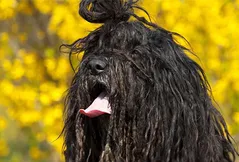
Mudi
The Mudi is a medium-size sheepdog, extremely versatile, intelligent, alert, agile, all-purpose Hungarian farm dog.
Overall Status
| Height | 15 to 18.5 inches |
| Temperament | Loyal, Intelligent, Active |
| Weight | 18 to 28.75 pounds |
| Life Expectancy | 12 to 14 years |
| Coat Color | Black, Brown, Fawn, Gray, Merle, White |
| Barking Level | Likes To Be Vocal |
Quick Factors
| Playfulness | |
| Dog Friendly | |
| Exercise Need | |
| Grooming Needs | |
| Strangers Friendly | |
| Family Affectionate |
Daily Care
Grooming Tips
The Mudi’s coat sheds dirt (and hair, of course) and doesn’t require frequent bathing. Weekly brushing is usually all it takes and the coat needs no trimming.If your Mudi is like most, he will enjoy swimming in a pool, lake or ocean. Follow that with a thorough freshwater rinse to remove chlorine, algae or salt and restore the spring to his coat, and he’s good to go.The Mudi sheds in the spring and doesn’t fully regain his coat until the end of summer.The rest is basic care. Trim the nails every few weeks or as needed. Brush the teeth often — with a vet-approved pet toothpaste — for good overall health and fresh breath.
Exercise Tips
A bundle of energy and athleticism, the Mudi craves exercise just as he does food, water and air. He loves to play and is a great companion for those with active lifestyles. He will readily play ball and can quickly learn to play Frisbee. Of course, a nice jog through the park or hike in the woods would do the Mudi just fine.The Mudi tends to be a jumper. This is why he excels in agility courses. An adequate fenced area is absolutely necessary with this breed. Although he is on the small side, a six-foot fence is best to contain him.
Feeding Tips
Because the Mudi is an energetic and athletic dog, it is of the utmost importance that he be fed a high-quality diet of dry kibble. Dry food helps to maintain proper oral hygiene as it removes plaque and other debris caught between the dog’s teeth. It also prevents tooth decay and bad breath.Any diet should be appropriate to the dog’s age (puppy, adult, or senior). Some dogs are prone to gettingoverweight, so watch your dog’s calorie consumption and weight level.Treatscan be an important aid in training, but giving too many can cause obesity.Learn about whichhuman foodsare safe for dogs, and which are not. Check with your vet if you have any concerns about your dog’s weight or diet.Clean, fresh water should be available at all times.
Health Tips
The Mudi is generally a very healthy breed of dog. There have been minimal incidences of hip dysplasia however; this can also be triggered because of the dog’s environment. Eye problems such as cataracts have been seen in the breed. Epilepsy has recently been listed as an issue within the breed.
Trainability
The Mudi is vocal, alert, energetic, intelligent, biddable, adaptable, and always enthusiastic aboutany job that needs to be done. Needless to say, these traits make them very trainable and eager to please. The Mudi is also sensibly suspicious and, therefore, an excellentwatchdog.Training must be done in a positive way.Harsh training tactics do not work with this breed as they will quickly shy away from the training session. Treats work quite well and are an incentive for the dog to learn the behavior you are teaching. Housebreaking can be a problem so careful attention to the Mudi’s signals for needing to go outdoors is important.Mudis excel in obedience work as well as in agility courses. Their intelligence and stamina also make them great candidates for search and rescue work. Of course, they are perfect for herding trials too.
History
The Mudi has probably been in existence since the 18th Century, but the exact time is difficult to pinpoint due to the confusion in the different names of the herding dogs that were used in Hungary. While it is commonly believed that the Puli is the oldest of the Hungarian sheep herding breeds, and that the Pumi and the Mudi were derived from that breed, that may not be the case. It is possible that the Mudi, with its many ancient features, is the result of crosses between spitz-type dogs and other naturally occurring herding dogs of the time and region. The breed’s history is not precisely known. The Mudi was only officially recognized as a breed in 1936.






